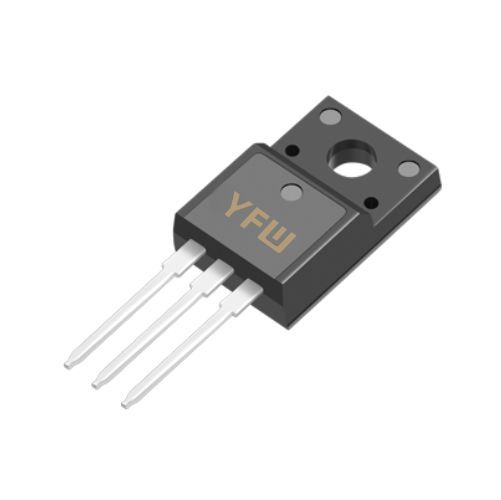A diode is a two-terminal device with a single PN junction, allowing current to flow in one direction while blocking it in the other. Its primary role is rectification, voltage regulation, or signal demodulation. A transistor, however, is a three-terminal device (base, emitter, collector) with two PN junctions. It functions as an amplifier or switch, relying on the interaction between the base current and the collector-emitter current.
The critical difference lies in their operational principles: diodes are passive devices dependent on voltage biasing, while transistors are active devices requiring a controlling input (base current) to modulate output signals. This structural and functional disparity makes direct substitution challenging.
A transistor’s internal structure contains two PN junctions: the base-emitter junction (BEJ) and the base-collector junction (BCJ). If one leg (emitter or collector) is broken, the remaining two terminals might theoretically form a diode-like structure. However, this depends on which leg is damaged:
Broken Base Leg:
The base is the control terminal of a transistor. Without it, the device loses its ability to amplify or switch. The remaining emitter and collector cannot function as a diode because the BEJ and BCJ are interdependent. Even if one junction appears to conduct, the lack of base control renders it unstable and unreliable.
Broken Emitter or Collector Leg:
If either the emitter or collector is broken, the intact BEJ or BCJ can potentially act as a diode. For example, in an NPN transistor, the BEJ (base-emitter) has a forward voltage drop similar to a silicon diode (~0.7V), while the BCJ (base-collector) has a higher reverse breakdown voltage (30–50V). By shorting the base to the intact collector or emitter, the remaining junction can rectify current, albeit with limitations in current handling and voltage tolerance.
Using a transistor as a diode requires careful consideration of its internal structure and external connections. Here are five common configurations for NPN transistors:
Base-Collector Shorting:
Shorting the base and collector (B=C) creates a diode with the emitter as the cathode. This configuration has a low reverse breakdown voltage (~7–9V) due to the BEJ’s inherent characteristics.
Base-Emitter Shorting:
Shorting the base and emitter (B=E) turns the collector into the anode. The BCJ, designed for higher voltage operation, offers a reverse breakdown voltage of 30–50V, making it suitable for applications requiring moderate voltage handling.
Open Collector or Emitter:
If the collector is left open, the base-emitter junction can act as a low-voltage diode. Conversely, an open emitter allows the base-collector junction to function as a higher-voltage diode. However, these configurations are less stable due to parasitic capacitances and leakage currents.
Emitter-Collector Shorting:
Shorting the emitter and collector (E=C) forces current through the base-collector junction. This setup is inefficient and not recommended due to excessive power dissipation.
Reverse Polarity Usage:
Inverting the voltage across the remaining junctions (e.g., using the collector as the cathode and the base as the anode) may yield limited diode-like behavior, but it risks damaging the device due to reverse-biased junction stress.
While a transistor’s PN junctions can mimic a diode, their performance falls short of dedicated diodes in several key areas:
Current Handling:
Transistors are optimized for current gain, not high-current rectification. The BEJ or BCJ may overheat if subjected to sustained currents exceeding their rated capacity (typically 10–100mA for small-signal transistors).
Voltage Ratings:
The reverse breakdown voltage of a transistor’s junctions is often lower than that of standard diodes. For example, the BEJ of a silicon transistor may break down at 7–9V, while a diode like the 1N4001 has a reverse voltage rating of 50V. Using a transistor in high-voltage applications could lead to catastrophic failure.
Dynamic Response:
Transistors have slower reverse recovery times compared to fast-recovery diodes, making them unsuitable for high-frequency applications like switching power supplies.
Reliability:
Damaged transistors lack the robust packaging and quality control of commercial diodes. Cracked leads or exposed semiconductor material increase the risk of environmental contamination and mechanical failure.
Despite the theoretical possibilities, substituting a transistor for a diode is generally discouraged in critical or long-term applications. Here’s why:
Cost-Effectiveness:
Dedicated diodes are inexpensive and readily available. Repurposing a transistor saves minimal resources and introduces unnecessary risks.
Design Complexity:
Engineers must carefully analyze circuit requirements, junction characteristics, and thermal constraints—a process that negates the benefit of a quick fix.
Safety:
In power electronics or automotive systems, a failed transistor-diode substitute could cause cascading failures, compromising equipment or personnel safety.
At YFW (佑风微), we understand the importance of precision and reliability in electronic components. While repurposing a damaged transistor may seem tempting, our extensive range of diodes—including rectifiers, Schottky, and TVS (Transient Voltage Suppression) devices—are engineered to meet stringent performance standards.
Our products undergo rigorous testing to ensure low forward voltage drop, high reverse voltage ratings, and fast switching speeds, making them ideal for applications ranging from consumer electronics to industrial automation. For critical designs, we recommend consulting our technical datasheets or contacting our support team to select the optimal diode for your specific requirements.
While a transistor with a broken emitter or collector can theoretically function as a diode in simple, low-stakes applications, this approach is inherently flawed. The performance limitations, reliability risks, and lack of cost-effectiveness outweigh any potential benefits. For robust and efficient solutions, always rely on purpose-built diodes like those offered by YFW. By prioritizing quality components, engineers can ensure their designs operate safely, efficiently, and with long-term durability.
For more insights into semiconductor applications and product innovations, visit www.yfwdiode.com. 